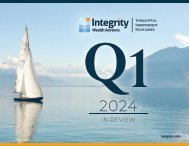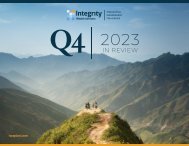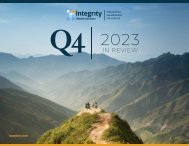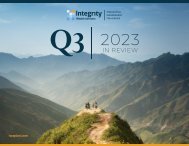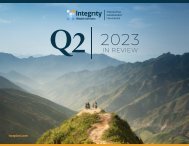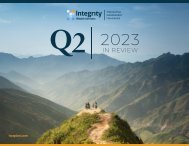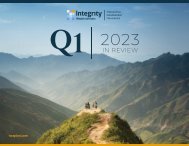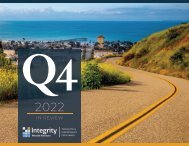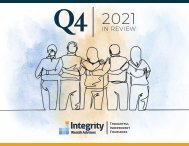2022 Q1 In Review - Integrity Wealth Advisors, Ventura | Ojai, California
We entered 2022 confronting many challenges. Omicron was running rampant, we faced the highest inflation in 40 years, and saw on the horizon interest rate hikes and elevated equity valuations. Then, on February 21st, just as the latest COVID wave was waning, an unexpected challenge arose - Russian troops began to invade Ukraine. Our challenges here in the United States are nothing compared to that of the Ukrainian people’s as a result of Putin's War, and our hearts are with them.
We entered 2022 confronting many challenges. Omicron was running rampant,
we faced the highest inflation in 40 years, and saw on the horizon interest rate
hikes and elevated equity valuations. Then, on February 21st, just as the latest
COVID wave was waning, an unexpected challenge arose - Russian troops
began to invade Ukraine. Our challenges here in the United States are nothing
compared to that of the Ukrainian people’s as a result of Putin's War, and our
hearts are with them.
You also want an ePaper? Increase the reach of your titles
YUMPU automatically turns print PDFs into web optimized ePapers that Google loves.
<strong>Q1</strong><br />
<strong>2022</strong><br />
IN REVIEW
TOTAL RETURN <strong>2022</strong> <strong>Q1</strong> + NEWSWORTHY EVENTS<br />
3%<br />
January 3 - The Dow<br />
Jones and S&P 500<br />
both set new record<br />
highs to start out the<br />
new year, even as<br />
Omicron remains a<br />
major concern<br />
January 4 - ADP payroll<br />
estimates 807,000<br />
private-sector jobs were<br />
added in December,<br />
more than double the<br />
consensus estimate<br />
S&P 500 TOTAL RETURN<br />
January 12 - Consumer prices rise 0.5%<br />
in December and push inflation rate to<br />
nearly 40-year high of 7%<br />
February 21 - Russian President Vladimir<br />
Putin signs a decree declaring the Luhansk<br />
People's Republic and Donetsk People's<br />
Republic as independent from Ukraine, and<br />
begins to move troops into the region<br />
February 24 - Russia begins a fullscale<br />
invasion of Ukraine, prompting<br />
countries to impose even harsher<br />
sanctions on Russia's government<br />
MSCI ACWI EX USA TOTAL RETURN<br />
March 2 - The United<br />
Nations reports that over a<br />
million refugees have now<br />
fled from Ukraine to other<br />
countries<br />
March 8 -The US and<br />
UK announce a ban on<br />
Russian oil, while the EU<br />
announces a two-thirds<br />
reduction in its demand<br />
for Russian gas<br />
BARCLAYS US AGGREGATE TOTAL RETURN<br />
March 10 - The 10-year treasury<br />
yield rose and topped 2% as US<br />
inflation data confirmed rapidly<br />
rising prices<br />
March 16 - the Fed approves first<br />
interest rate hike in more than<br />
three years, sees six more ahead<br />
March 29 - Sentiment changed<br />
as news broke that Russia would<br />
be easing some military action<br />
across Ukraine<br />
1%<br />
-1%<br />
-3%<br />
-5%<br />
-7%<br />
-9%<br />
-4.59%<br />
-5.33%<br />
-5.93%<br />
-11%<br />
-13%<br />
January<br />
February<br />
March<br />
12%<br />
S&P 500 TOTAL RETURN<br />
MSCI ACWI EX USA TOTAL RETURN<br />
BARCLAYS US AGGREGATE TOTAL RETURN<br />
As of close 3/31/<strong>2022</strong><br />
11%<br />
10.42%
A BUMPY START TO A NEW YEAR<br />
<strong>2022</strong><br />
<strong>Q1</strong><br />
IN REVIEW<br />
We entered <strong>2022</strong> confronting many challenges. Omicron was running rampant,<br />
we faced the highest inflation in 40 years, and saw on the horizon interest rate<br />
hikes and elevated equity valuations. Then, on February 21st, just as the latest<br />
COVID wave was waning, an unexpected challenge arose - Russian troops<br />
began to invade Ukraine. Our challenges here in the United States are nothing<br />
compared to that of the Ukrainian people’s as a result of Putin's War, and our<br />
hearts are with them.<br />
The day that Russia invaded Ukraine, the rest of the world began imposing<br />
sanctions on Russia to encourage Putin to rethink this war. These sanctions do<br />
have consequences for us as consumers - we need look no further than the gas<br />
station down the street. We’ve seen the first interest rate hike in two years to<br />
combat inflation, and the Fed laid out plans for six more rate increases.<br />
As the Omicron wave passed, a divergence in COVID-19 policies occurred as<br />
many communities removed mask requirements and began to return to prepandemic<br />
life. This was not enough to fuel the stock market, however. Equities<br />
had a challenging quarter as inflation ticked to a 40-year high and interest rates<br />
rose. Bonds were also crushed this quarter amid concerns about rising interest<br />
rates and inflation. Commodities led the way with a first-quarter return of 25.5%,<br />
driven by slowly improving supply chain constraints and oil prices resulting from<br />
import bans on Russian oil.<br />
The economic recovery from the pandemic has indeed been a bumpy one. By the<br />
end of last year, the US economy had recovered its pre-recession output level,<br />
exceeding it by 3.2%. The Omicron wave slowed growth this quarter, but we feel<br />
consumer and business spending will spur strong growth in the second quarter<br />
as the economy continues to reopen. We also expect unemployment to continue<br />
to fall as wages rise and demand for labor continues to be high. <strong>In</strong> addition, we<br />
feel earnings will continue to grow this year, albeit not at the remarkable pace<br />
of last year. While inflation is likely to remain well above the Fed's 2% target, we<br />
anticipate moderation throughout the year as supply chain constraints ease. This<br />
gives us reason to be optimistic for growth in equities through the remainder of<br />
the year, though we should continue to count on it being a bumpy ride.<br />
ECONOMIC CHARTS & NOTES<br />
CONSUMER SENTIMENT Consumer sentiment dipped to its lowest level<br />
since August 2011 in March amid lower living standards and rising pessimism<br />
about inflation. <strong>In</strong>flation was also to blame for slower retail sales growth as<br />
people spent more on gas and groceries but less on online shopping.<br />
EMPLOYMENT The unemployment rate fell to its lowest level since<br />
February 2020 and labor force participation rose to its highest level since<br />
the start of the pandemic. The addition of 1,685K private sector jobs in <strong>Q1</strong><br />
also portayed a healthy US labor market supported by consumer demand.<br />
US Retail Sales<br />
Consumer Sentiment<br />
Unemployment Rate<br />
NonFarm Payroll<br />
US Retail Sales % Chg<br />
34%<br />
28%<br />
22%<br />
16%<br />
10%<br />
4%<br />
-2%<br />
-8%<br />
-14%<br />
Jan '19<br />
Jul '19<br />
Jan '20<br />
Jul '20<br />
Jan '21<br />
Jul '21<br />
Jan '22<br />
100<br />
95<br />
90<br />
85<br />
80<br />
75<br />
70<br />
65<br />
60<br />
Consumer Sentiment<br />
Unemployment Rate %<br />
16%<br />
14%<br />
12%<br />
10%<br />
8%<br />
6%<br />
4%<br />
2%<br />
Jan ' 19<br />
Jul '19<br />
Jan '20<br />
Jul '20<br />
Jan '21<br />
Jul '21<br />
Jan '22<br />
2200<br />
-825<br />
-3850<br />
-6875<br />
-9900<br />
-12925<br />
-15950<br />
-18975<br />
-22000<br />
NonFarm Payroll
ECONOMIC CHARTS & NOTES<br />
CONSUMER PRICE INDEX Largely driven by surging gasoline prices, the<br />
Consumer Price <strong>In</strong>dex (CPI) increased 7.9% in February - the biggest annual<br />
increase in 40 years. Excluding energy and food, inflation was up 6.4%, driven<br />
by higher auto and housing prices.<br />
CONSUMER SPENDING <strong>In</strong>flation-adjusted disposable personal income<br />
decreased slightly in February but consumers continued to spend, despite<br />
having diminished purchasing power.<br />
Amount in Thousands Y/Y % Chg<br />
8%<br />
7%<br />
6%<br />
5%<br />
4%<br />
3%<br />
2%<br />
1%<br />
JOB OPENINGS & HIRES Retail hiring rebounded sharply, from a surprisingly<br />
soft holiday hiring period to near record levels in February. Job openings in the<br />
industry also picked up as Omicron cases fell and restrictions were lifted.<br />
1200<br />
1000<br />
800<br />
600<br />
400<br />
200<br />
0<br />
Jan '18<br />
Jul '18<br />
CPI Less Food<br />
0%<br />
Jan ' 18 Jul '18 Jan ' 19<br />
Jan '19<br />
Jul '19<br />
Retail Hires<br />
Jul '19<br />
Jan '20<br />
Jan '20<br />
Jul '20<br />
Jul '20<br />
CPI All<br />
Jan '21<br />
Retail Openings<br />
Jan '21<br />
Jul '21 Jan '22<br />
Jul '21<br />
Jan '22<br />
% Chg Year-over-year<br />
GDP Led by strong consumer and business spending, US economic growth<br />
accelerated to 6.9% in Q4, capping the strongest year since 1984. Growth is<br />
expected to have slowed considerably in <strong>Q1</strong> due to the spread of Omicron, lack of<br />
fiscal stimulus, supply chain disruptions, and the Russia-Ukraine conflict.<br />
% Growth<br />
30<br />
25<br />
20<br />
15<br />
10<br />
5<br />
0<br />
-5<br />
-10<br />
-15<br />
Jan '19<br />
35%<br />
30%<br />
25%<br />
20%<br />
15%<br />
10%<br />
5%<br />
0%<br />
-5%<br />
-10%<br />
-15%<br />
-20%<br />
-25%<br />
-30%<br />
-35%<br />
Jul '19<br />
2017<br />
Consumption<br />
Jan '20<br />
Jul ' 20<br />
Jan '21<br />
GDP<br />
Disposable <strong>In</strong>come<br />
Jul '21<br />
Jan '22<br />
<strong>Q1</strong> Q2 Q3 Q4 <strong>Q1</strong> Q2 Q3 Q4 <strong>Q1</strong> Q2 Q3 Q4 <strong>Q1</strong> Q2 Q3 Q4 <strong>Q1</strong> Q2 Q3 Q4<br />
2018 2019 2020 2021
6 THINGS YOU CAN DO DURING A<br />
VOLATILE STOCK MARKET<br />
<strong>2022</strong><br />
<strong>Q1</strong><br />
IN REVIEW<br />
Episodes of market volatility are an alarming but normal feature of long-term investing. They aren't fun, but you should expect to see market declines periodically<br />
throughout your lifetime. Still, it’s hard to sit still when the market is sliding. You can't help but think, ”shouldn't I be doing something?" While every investor is<br />
different, there are six steps that everyone should consider.<br />
DURING MARKET VOLATILITY:<br />
Resist the urge to sell<br />
based solely on recent<br />
market movements.<br />
Selling stocks when<br />
markets drop can<br />
make temporary losses<br />
permanent. Staying the<br />
course, while difficult<br />
emotionally, may be<br />
healthier for your<br />
portfolio. This doesn't<br />
mean you should hold<br />
on blindly, but we<br />
suggest considering an<br />
investment's prospects<br />
and its role in your<br />
portfolio rather than<br />
being guided by noise<br />
and fear.<br />
Take the long view.<br />
Markets typically go up<br />
and down, and you're<br />
likely to experience<br />
several significant<br />
declines during a long<br />
investing career. But<br />
even bear markets—<br />
that is, periods when<br />
the market fell by more<br />
than 20%—historically<br />
have been relatively<br />
short compared to<br />
bull markets. Because<br />
timing the market's ups<br />
and downs is nearly<br />
impossible, all investors<br />
would do well to ignore<br />
the noise and stay<br />
focused on their plans.<br />
<strong>Review</strong> your risk<br />
tolerance and your<br />
risk capacity. Risk<br />
tolerance is your ability<br />
to emotionally handle<br />
big price swings; risk<br />
capacity is your financial<br />
ability to take a loss.<br />
Market downturns can<br />
be a wake-up call to<br />
reconsider your risk<br />
tolerance, although we<br />
recommend waiting<br />
until you're calm. Risk<br />
capacity, however,<br />
can—and should—be<br />
considered at any time.<br />
Do you have enough<br />
cash to handle near-term<br />
goals? The money you'll<br />
need soon or can't afford<br />
to lose shouldn't be in<br />
the stock market—it's<br />
best invested in relatively<br />
stable assets. Building<br />
an appropriate cash<br />
reserve can help you<br />
stay calm when stock<br />
markets are not.<br />
Make sure you have a<br />
diversified portfolio.<br />
Volatile markets can also<br />
reveal that portfolios<br />
their owners thought<br />
were appropriately<br />
diversified are not at all.<br />
If you haven't looked at<br />
your portfolio recently<br />
to make sure you<br />
understand what each<br />
asset class is doing and<br />
that the mix matches<br />
your target asset<br />
allocation, now is an<br />
excellent time to become<br />
reacquainted with it.<br />
Consider including<br />
defensive assets for<br />
more stability. Defensive<br />
assets, such as cash and<br />
cash equivalents, and<br />
specific fixed-income<br />
securities, can help<br />
stabilize a portfolio when<br />
stocks are slipping. Also,<br />
if you expect to spend<br />
from your portfolio within<br />
the next few years, it's a<br />
good idea to keep that<br />
money in assets that<br />
historically have been<br />
relatively liquid and less<br />
volatile than stocks, such<br />
as cash and short-term<br />
bonds. This can help you<br />
avoid having to sell in a<br />
down market.<br />
Rebalance your portfolio<br />
as needed. Market<br />
changes can skew<br />
your allocation from its<br />
original target. Over time,<br />
assets that have gained<br />
value will account for<br />
more of your portfolio,<br />
while those that have<br />
declined will account for<br />
less. Rebalancing means<br />
selling positions that<br />
have become overweight<br />
in relation to the rest<br />
of your portfolio, and<br />
moving the proceeds<br />
to positions that have<br />
become underweight. It's<br />
a good idea to do this at<br />
regular intervals.
CAN COMMODITIES HELP MY INVESTMENT PORTFOLIO?<br />
Commodities are physical goods, such as grains, livestock, oil and energy<br />
products, or precious and industrial metals. They may be used as-is or to<br />
make other goods. Commodities are needed globally by everyone, directly or<br />
indirectly. They are becoming a more mainstream investment choice, and it can<br />
make sense to partially include them in your portfolio. <strong>In</strong>vesting in commodities<br />
can provide growth potential and diversification, as well as hedge against<br />
inflation. Let us consider the latter first.<br />
While the economy has been in a low-inflation regime for years, we are now<br />
painfully aware that inflation has been trending higher. This can be a significant<br />
drag on the performance of your investments, as well as the purchasing power<br />
of your dollars. Protecting against inflation is critical for investors, especially<br />
those in the later stages of their careers, as well as those who are retired, or just<br />
about to retire. Commodity prices have historically been in decline since 2011,<br />
but around the middle of 2021 the price trend reached an inflection point and<br />
has since been rallying. <strong>In</strong>flation and geopolitical events, such as the February<br />
24th invasion of Ukraine by Russia, have caused commodity prices to rise<br />
significantly, and the growth potential trend shows no sign of going away in<br />
the near term. This is due to the persisting factors of rising demand, supply<br />
shortages, and deglobalization forces. <strong>In</strong>vesting in commodities can protect<br />
against inflation, because their price increases will offset the monetary value<br />
loss as these inflationary trends continue. The following chart shows how<br />
commodities ‘track’ with inflation, as evidenced by how they follow the rising<br />
price indicator of the Consumer Price <strong>In</strong>dex (CPI).<br />
Commodities also offer further growth potential when compared to the current<br />
valuation of US stocks. Historically speaking, commodity prices are cheap<br />
today compared to US stock prices. Evidence of this can be found in the chart<br />
below, which divides the value of the S&P GSCI Commodity <strong>In</strong>dex by the value<br />
of the broad stock market S&P 500 <strong>In</strong>dex. We can see the relatively undervalued<br />
nature of commodities as compared to stocks, as the commodity to stock<br />
index ratio is at all-time lows. Commodities therefore have greater potential<br />
to appreciate, as stock prices may moderate in valuation in the same overall<br />
economic environment. Logically, this would bring the stock/commodity ratio<br />
back up toward the historical chart mean (middle).<br />
Finally, commodities provide diversification in a multi-asset portfolio, as they<br />
have historically done well in inflationary markets. Commodity prices having<br />
an increasing value response to inflation and rising interest rates. Compare<br />
this to certain classes of stocks, that conversely will decline in price and value<br />
due to rising material costs and interest rates, as these make the cost of doing<br />
business higher. <strong>In</strong>creasing costs, in turn, lower earnings and profits. This<br />
offsetting effect can also apply when comparing bonds to commodities, as<br />
bond prices are temporarily suppressed by rising interest rates, as we have<br />
recently experienced. Clearly, the aforementioned reasons demonstrate that<br />
holding commodities as a part of your investment portfolio can offer protection,<br />
diversity, and potential for growth.<br />
Sources: Capital Group, Refinitiv Datastream, Standard & Poor's, Bureau of Labor Statistics, U.S. Department of Labor. The price ratio between the S&P GSCI Total Return <strong>In</strong>dex and the Standard & Poor’s 500 Composite<br />
<strong>In</strong>dex is scaled to 100. GSCI data shown from 2/27/70 to 2/28/22. Commodity index returns vs. inflation data shown from 1/31/89 to 2/28/22.
IS THIS THE END OF GLOBALIZATION?<br />
<strong>2022</strong><br />
<strong>Q1</strong><br />
IN REVIEW<br />
Globalization in all its forms, be it social, economic or political, has been rising since around the 1970s. This has caused the real cost<br />
of finished goods to trend down over the decades, and there is evidence that the world has become more peaceful, with fewer<br />
wars and war-related deaths than in years past.<br />
It goes without saying that the events of the past two years, including the US-China trade war, the COVID-19 pandemic,<br />
and now the Russia-Ukraine war and resulting international sanctions, have challenged the merits of globalization.<br />
<strong>In</strong>flation is at a 40-year high and Western Europe is facing a severe energy crisis, prompting policymakers and<br />
multinational companies to rethink supply chains that crisscross the globe, as well as sourcing materials and<br />
labor from unfriendly jurisdictions.<br />
Russia's invasion of Ukraine "has put an end to the globalization we have experienced over the last three<br />
decades," says Larry Fink, co-founder and CEO of BlackRock, the world's largest asset management firm.<br />
<strong>In</strong> this week's letter to shareholders he adds that "companies and governments will also be looking more<br />
broadly at their dependencies on other nations,” as a result of not just the war but also the pandemic.<br />
"Nearshoring," the practice of moving business operations closer to home, could benefit Mexico, Brazil, and<br />
even the US.<br />
China is key to understanding the consequences of unchecked globalization. China has long been the<br />
world's factory. Of the ten busiest seaports in the world, six are in China. An estimated one-third of global<br />
shipping passes through the South China Sea.<br />
Today we are seeing the risks of depending so heavily on one country for the movement of goods. China<br />
is experiencing an unexpected surge in COVID cases. Due to it’s zero COVID policy, businesses, factories,<br />
and warehouses have been shut down, particularly in Shanghai, a major port city that's home to more than<br />
26 million people.<br />
Even though the Port of Shanghai, the world's busiest port, has reportedly remained open, a shipping<br />
logjam is worsening as trucks are not available to move product. According to data from VesselsValue, port<br />
congestion is at an all-time high, with the number of ships waiting to load and unload going parabolic.<br />
Shipping giant Maersk warned clients this week that the lockdowns will likely result in even higher shipping<br />
costs, writing that "there will be longer delivery times and a possible rise in transport costs such as detour fees<br />
and highway fees." These extra fees will, in turn, be passed down the supply chain to the end consumer, who is<br />
already having to deal with rampant inflation.<br />
Between shipping logjams, the US outsourcing of computer chip manufacturing, and Europe's reliance on Russian energy,<br />
we have certainly seen the risks of globalization. However, deglobalization would undoubtedly only push inflation higher. The<br />
direction the world will move in as a result of the events of the past two years remains to be seen.<br />
Sources: NY TImes. US Funds.
INVESTMENT<br />
MANAGEMENT<br />
PHILOSOPHY<br />
The complex, ever-changing investment world of today<br />
requires an investment process that is overseen by a team<br />
of experienced investment professionals. Global capital<br />
markets present investors with a host of challenges due to<br />
the combination of an overwhelming amount of information<br />
to analyze and the endless supply of conflicting opinions and<br />
narratives surrounding financial markets. The time and expertise<br />
required to perform in-depth investment research and to make<br />
timely and informed portfolio management decisions requires<br />
both a clear investment process and an experienced investment<br />
team to implement the process.<br />
An old adage states that there is accomplishment through<br />
many advisors. We agree and embrace a variety of investment<br />
perspectives through our investment committee. Our investment<br />
philosophy is well grounded in global macro-economic analysis.<br />
<strong>In</strong>vestment ideas are carefully vetted through a process which<br />
incorporates the diverse range of investment backgrounds<br />
within our firm. This process of multifaceted analysis ensures<br />
that only the strongest investment ideas survive. We are<br />
committed to striking the right balance between risk and<br />
return through managing global, multi-asset class investment<br />
portfolios.<br />
INDEPENDENCE &<br />
CLIENT FOCUS<br />
DIVERSIFICATION<br />
TOP-DOWN, THEMATIC<br />
APPROACH<br />
PERFORMANCE WITH<br />
LIQUIDITY<br />
VARIED INVESTMENT<br />
PERSPECTIVES<br />
OPTIMIZATION OF<br />
EXPENSES AND TAXES<br />
THE INVESTMENT PROCESS<br />
ASSESSMENT OF GLOBAL<br />
ECONOMIC & INVESTMENT<br />
ENVIRONMENT<br />
ASSESS & ANALYZE<br />
THEMES<br />
RESEARCH INVESTMENT<br />
VEHICLES TO FIND<br />
EFFECTIVE IMPLEMENTATION<br />
IDENTIFY<br />
OPPORTUNITIES<br />
STRATEGIC ASSET<br />
ALLOCATION -<br />
Geographies, Sectors,<br />
Capitalizations<br />
INVESTMENT SELECTION -<br />
Open/Closed End Funds, ETFs, Stocks & Bonds
INVESTMENT COMMITTEE<br />
2021<br />
Q4<br />
IN REVIEW<br />
The <strong>In</strong>vestment Committee meets formally<br />
each quarter, and more frequently if market<br />
conditions warrant, to discuss the state of<br />
the global economy and capital markets and<br />
to assess the current asset allocation and<br />
positioning of our portfolios. There’s an art<br />
to striking the right balance between risk and<br />
return; pursuing that symmetry is the core of<br />
our investment philosophy. We are fiduciaries<br />
and have our interests aligned with our<br />
clients, as we invest alongside them.Contact<br />
us at investmentcommittee@iwaplan.com<br />
with any questions or concerns.<br />
STEPHEN WAGNER<br />
CEO, <strong>In</strong>vestment Advisor,<br />
CFP ® , CPFA<br />
35+ Years Experience*<br />
VICTORIA BREEN<br />
<strong>In</strong>vestment Advisor &<br />
Financial Planner<br />
40+ Years Experience*<br />
MARTHA LAFF<br />
<strong>In</strong>vestment Advisor,<br />
ChFC ® , CLU ® , CRPC ®<br />
30+ Years Experience*<br />
ANDREW MURTHA<br />
Financial Analyst,<br />
MBA<br />
20+ Years Experience*<br />
BOB CHEATHAM<br />
Financial Planner,<br />
CRPS®, MA<br />
MARGARET MARAPAO<br />
<strong>In</strong>vestment Advisor &<br />
Financial Planner, CFP ®<br />
CHRISTOPHER WAGNER<br />
<strong>In</strong>vestment Advisor &<br />
Financial Planner, CPFA<br />
LAINE MILLER<br />
<strong>In</strong>vestment Advisor &<br />
Financial Planner<br />
DOUG ECKER<br />
<strong>In</strong>vestment Advisor &<br />
Financial Planner, CRPS®<br />
15+ Years Experience*<br />
* Financial services experience. <strong>In</strong>vestment Advisory Services are offered through investment advisor representatives of <strong>In</strong>tegrity <strong>Wealth</strong> <strong>Advisors</strong>, a Federally Registered <strong>In</strong>vestment Advisor.<br />
THOUGHTFUL<br />
INDEPENDENT<br />
FIDUCIARIES<br />
<strong>In</strong>tegrity <strong>Wealth</strong> <strong>Advisors</strong> has<br />
been committed to helping<br />
individuals, families, and<br />
businesses grow, preserve, and<br />
distribute wealth since 1979<br />
VENTURA<br />
196 S Fir St, Ste 140<br />
<strong>Ventura</strong>, CA 93001<br />
(805) 339-0760<br />
ventura@iwaplan.com<br />
OJAI<br />
205 S Signal St,<br />
<strong>Ojai</strong>, CA 93023<br />
(805) 646-3729<br />
ojai@iwaplan.com
THE IMPACT OF<br />
SOUND FINANCIAL<br />
PLANNING<br />
Recent Vanguard research 1 shows that an experienced<br />
wealth management team not only adds peace of mind,<br />
but also may add about 3 percentage points of value in<br />
net portfolio returns over time. What does this mean? Your<br />
team has the ability and the time to evaluate your portfolio<br />
investments, meet with you to discuss objectives, and<br />
help get you through tough markets. All of these factored<br />
together potentially add value to your net returns (returns<br />
after taxes and fees) over time. But the most interesting part<br />
of this research is that it shows that financial planning and<br />
financial coaching contributed to the greater majority of the<br />
added net 3% in net portfolio returns.<br />
It’s important to realize how valuable making sound financial<br />
planning decisions is and that value is added by your<br />
financial planning team. As investors, our emotions can be<br />
our worst enemy, especially when the markets are volatile,<br />
and guidance from a “behavioral coach” can save us from<br />
panic-selling and abandoning long-term financial plans.<br />
Numerous studies demonstrate that advisors can have a<br />
huge impact on investor finances, but it’s hard to say if these<br />
findings have been recognized and understood by everyday<br />
investors.<br />
Spending<br />
LONG-TERM CARE PLANNING<br />
Create a care plan<br />
The value of assistance from family and friends is roughly equal to paid long-term care.<br />
An adult child caring for a parent is seven times more likely than an individual providing<br />
care for their spouse. Women are more likely to require care and need more years of paid<br />
care if paid care is used. A care may help you avoid burdening others, ensure your<br />
family Long-term understands care your wishes planning and allow you to have more control over your care.<br />
Lifetime probability of needing assistance with two or more activities of daily living<br />
80%<br />
60%<br />
40%<br />
20%<br />
0%<br />
64%<br />
75%<br />
Any type<br />
Providers of unpaid eldercare<br />
60%<br />
40%<br />
20%<br />
51%<br />
27%<br />
23%<br />
26%<br />
20%<br />
24%<br />
Only unpaid care<br />
(family / friends)<br />
7%<br />
Men<br />
33% 34%<br />
20%<br />
Women<br />
3%<br />
6%<br />
Paid home care Nursing home Assisted living<br />
May use more than 1 type of paid care<br />
Duration of paid care age 65+ if paid care is used<br />
45%<br />
30%<br />
15%<br />
37%<br />
33%<br />
Men<br />
Women<br />
27%<br />
26%<br />
35%<br />
43%<br />
Crea<br />
The v<br />
and<br />
to pa<br />
carin<br />
time<br />
indiv<br />
their<br />
Wom<br />
requ<br />
years<br />
care<br />
A car<br />
avoid<br />
ensu<br />
unde<br />
and<br />
cont<br />
DREAM.<br />
PLAN.<br />
ENJOY.<br />
0%<br />
0%<br />
< 3 years 3-5 years 5+ years<br />
Long-term care includes needing help with two or more activities of daily living such as eating, dressing, bathing, transferring, and toileting<br />
or severe cognitive impairment. For the top chart, nursing home stays of less than 90 days are excluded because they may include recovery<br />
Long-term from injuries. care Unpaid includes caregivers needing may help care with for two more more than 1 activities person. of daily living such as eating, dressing, bathing, transferring,<br />
and Source: toileting U.S. Department or severe cognitive of Health impairment. and Human For Services, the top ASPE chart, Issue nursing Brief, home April 2019, stays What of less is the than long-term 90 days risk are excluded of needing because and receiving<br />
long-term services and supports, Table 3; U.S. Government Accountability Office, GAO-19-382, Retirement Security, Some Parental and<br />
they may includerecovery from injuries. Unpaid caregivers may care for more than 1 person.<br />
Spousal Caregivers Face Financial Risk, May 2019, Figure 1; U.S. Department of Health and Human Services, APSE Brief, January 2021, Longterm<br />
Services U.S. Department and Supports of Health for Older and Americans, Human Services, Risks and ASPE Financing, Issue Brief, 2020, April Table 2019, 1. Latest What data is the available long-term as of risk December of needing 31, and 2021.<br />
Source:<br />
receiving long-term services and supports, Table 3; U.S. Government Accountability Office, GAO-19-382, Retirement Security,<br />
Some Parental and Spousal Caregivers Face Financial Risk, May 2019, Figure 1; U.S. Department of Health and Human<br />
Services, APSE Brief, January 2021, Long-term Services and Supports for Older Americans, Risks and Financing, 2020, Table 1.<br />
Latest data available as of December 31, 2021.
BENEFITS OF SAVING & INVESTING EARLY<br />
Benefit of saving and investing early<br />
Starting your retirement savings early, being consistent year after year, and investing what you save are some of the keys to a successful<br />
retirement, due to the power of long-term compounding. It is never too early to start saving for retirement, but don’t be discouraged if you<br />
haven’t yet begun! As this chart shows, it is also never too late to begin consistently saving and investing for retirement. Creating a Financial<br />
Account growth of $200 invested/saved monthly<br />
<strong>In</strong>dependence Plan can bring clarity when answering that important question, “Can I achieve my retirement goals?”<br />
Sav<br />
People always ask us,<br />
“How much do I need<br />
to have saved when I<br />
reach retirement?” There<br />
is no one-size-fits-all<br />
answer, as your individual<br />
financial situation is<br />
distinct. A unique personal<br />
<strong>In</strong>dependence Plan will<br />
give you a clear answer.<br />
Saving<br />
$450,000<br />
$400,000<br />
$350,000<br />
$300,000<br />
Consistent Chloe invests from<br />
ages 25 to 65 earning 6.25%<br />
($96,000 total)<br />
Quitter Quincy invests from<br />
ages 25 to 35 earning 6.25%<br />
($24,000 total)<br />
Late Lyla invests from ages<br />
35 to 65 earning 6.25%<br />
($72,000 total)<br />
Ending portfolio<br />
$420,300<br />
$210,700<br />
77%<br />
66%<br />
Savi<br />
inve<br />
som<br />
succ<br />
the<br />
com<br />
ACCOUNT<br />
GROWTH<br />
OF $200<br />
INVESTED/<br />
SAVED<br />
MONTHLY<br />
$250,000<br />
$200,000<br />
$150,000<br />
$100,000<br />
$50,000<br />
$0<br />
Nervous Noah saves from ages<br />
25 to 65 in cash earning 2.0%<br />
($96,000 total)<br />
25 30 35 40 45 50 55 60 65<br />
Age<br />
$209,600<br />
$147,900<br />
<strong>In</strong>vestment return<br />
Savings<br />
89%<br />
35%<br />
The example above is for illustrative purposes only and not indicative of any investment. Compounding is the increasing value of assets due toinvestment return earned<br />
on both principal and prior investment gains.<br />
The above example is for illustrative purposes only and not indicative of any investment.<br />
Source: J.P. Morgan Asset Management, Long-Term Capital Market Assumptions. Compounding is the increasing value of assets due to<br />
investment return earned on both principal and prior investment gains.
VENTURA<br />
196 S Fir St, Ste 140<br />
<strong>Ventura</strong>, CA 93001<br />
(805) 339-0760<br />
ventura@iwaplan.com<br />
OJAI<br />
205 S Signal St,<br />
<strong>Ojai</strong>, CA 93023<br />
(805) 646-3729<br />
ojai@iwaplan.com<br />
Data / statistics cited are provided by the Federal Reserve Bank of St. Louis.<br />
The S&P 500 <strong>In</strong>dex or the Standard & Poor's 500 <strong>In</strong>dex is a market-capitalization-weighted index of the 500 largest U.S. publicly traded companies. The S&P<br />
500 is a float-weighted index, meaning company market capitalizations are adjusted by the number of shares available for public trading. <strong>In</strong>vestors cannot<br />
invest directly in an index. Note: <strong>In</strong>vestors cannot invest directly in an index. These unmanaged indices do not reflect management fees and transaction<br />
costs that are associated with most investments.<br />
The MSCI World ex USA <strong>In</strong>dex captures large and mid cap representation across 22 of 23 Developed Markets (DM) countries* – excluding the United States.<br />
With 1,012 constituents, the index covers approximately 85% of the free float-adjusted market capitalization in each country.<br />
The Barclays Capital U.S. Aggregate Bond <strong>In</strong>dex is the most common index used to track the performance of investment grade bonds in the U.S.<br />
The opinions expressed in this program are for general informational purposes only and are not intended to provide specific advice or recommendations<br />
for any individual or on any specific security. It is only intended to provide education about the financial industry. To determine which investments may be<br />
appropriate for you, consult your financial advisor prior to investing. Any past performance discussed during this program is no guarantee of future results.<br />
Any indices referenced for comparison are unmanaged and cannot be invested into directly. <strong>In</strong>vesting involves risk and possible loss of principal capital;<br />
please seek advice from a licensed professional.<br />
<strong>In</strong>tegrity <strong>Wealth</strong> <strong>Advisors</strong> is a registered investment adviser. Advisory services are only offered to clients or prospective clients where <strong>In</strong>tegrity <strong>Wealth</strong><br />
<strong>Advisors</strong> and its representatives are properly licensed or exempt from licensure. No advice may be rendered by <strong>In</strong>tegrity <strong>Wealth</strong> <strong>Advisors</strong> unless a client<br />
service agreement is in place.<br />
Vanguard research study; Source: Francis M. Kinniry Jr., Colleen M. Jaconetti, Michael A. DiJoseph, and Yan Zilbering, 2014. Putting<br />
a value on your value: Quantifying Vanguard Advisor’s Alpha. Valley Forge, Pa.: The Vanguard Group.<br />
Securities offered through LPL Financial, Member FINRA/SIPC. A separate entity from <strong>In</strong>tegrity <strong>Wealth</strong> <strong>Advisors</strong>.




